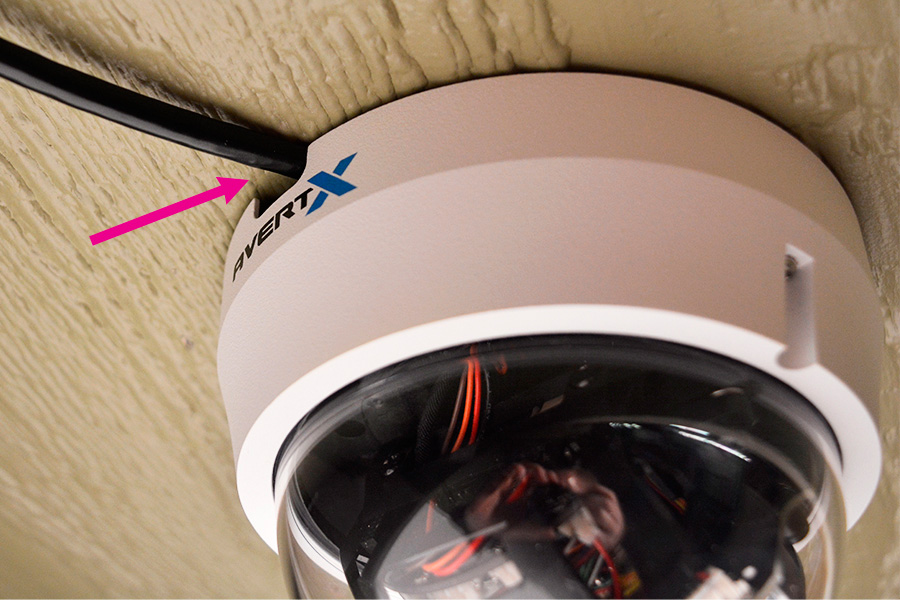Installation Planning and Tips
First Steps - Setup & Bench Testing
AvertX recommends a “bench test” before beginning installation of your system. A bench test is simply setting up your system before installation. This guarantees that all components of your system are in working order before going to the trouble of running cables and mounting cameras. To perform an effective bench test, follow these steps:
- Create an AvertX Connect account.
- Unpack your recorder and cameras and place them on a wide, flat surface such as a table or workbench. Make sure you have an easy way to connect to your modem or router for internet access.
- Connect a monitor to your recorder using the included HDMI cable.
- Connect the included mouse and keyboard to the USB ports on the front or back of the recorder.
- Connect the recorder to the internet using the provided ethernet cable.
- Connect the included power cord to the recorder and plug the other end into a standard household outlet.
- Power on and log in to the recorder using the default credentials.
DEFAULT CREDENTIALS
Username: admin
Password: 1234
- Follow the First Time Wizard to complete basic setup of your recorder.
Note: The First Time Wizard will prompt you to change your recorder admin password. Please save the password in a secure location. You will need the admin password for emergency access to the recorder. AvertX recommends using password manager software to securely save passwords.
- Add your recorder to your AvertX Connect account.
- Set the default camera password.
Note: Do not connect your cameras until you have set the default camera password.
- Connect your cameras to the back of the recorder using the included 100’ Cat5e camera cables.
Note: The cables do not need to be fully uncoiled for this test.
- Once you confirm that all components are working, proceed with installation.
Placing the Recorder
- When choosing a location for your NVR, consider access to cable routes, ventilation and physical security.
- For detailed information about placing your NVR, please see the DIY Guide Where Should I Place My NVR?
Running Wires
- Your system includes 100’ of Cat5e cable per camera, which is enough for most installations. If you need a longer cable to reach your camera installation location, you can use up to 300’ of Cat5e per camera. Distances greater than 300’ will require a Power Over Ethernet (PoE) switch or injector placed along the line that can be purchased at computer retailers like Newegg or Amazon.
- To protect against the elements and vandalism, the Cat5e camera cables should be routed through walls, crawl spaces, attics, or conduit. The IP66 waterproof connector is outdoor rated. YouTube contains many excellent videos with instructions on running wires.
- When planning the cable route to the back of the recorder, make sure to include the extra length that is needed for placing cables in ceilings, walls, or under overhangs.
- Most installations require one cable run per camera plus one to the recorder from the Internet router for remote access (optional).
- You may want to consider hiring a licensed electrician to run Cat5e camera cables and mount cameras. Depending on your location and difficulty of installation, cost can range from $50 to $200 per cable run. Most electricians provide free estimates.
- Avoid running Ethernet cable next to or through the same holes as 120v electrical wires to avoid data loss due to electrical interference. Ethernet cable should be kept at least 16 inches from 120v lines when running parallel and should only cross at a 90° angle.
- Consult your local codes before running cables through drop-ceilings. The included Cat5e cable is not plenum-rated, meaning they cannot be used in air ducts. Drop ceilings are considered plenum areas when they are used as an air return for heating/cooling systems and require plenum-rated cables.
- If your installation is in a commercial building, consult local fire codes. Plenum rated cable or other special considerations may be required.
- Run Ethernet cable away from electric motors/industrial equipment or industrial lighting or similar items that may generate a high level of electrical noise or interference. In some cases, it may be necessary to run shielded (STP) Ethernet cable.
- AvertX recommends protecting your cable by running through conduits or inside a wall since the cable is not outdoor or plenum rated.
- AvertX cameras and cables have waterproof connectors eliminating the requirement for a sealed electrical box to protect the connection.
Placing Cameras
- Cameras should be placed around 10 feet off the ground to gain a wider view of the recording area. This also helps to protect against accidental damage and vandals.
- To prolong the life of the camera, choose an outdoor location protected from the elements and out of direct sunlight. Under the eaves of a house or building overhang is an ideal location.
- Carefully plan the route for the Cat5e from the camera to the back of the recorder in advance. Depending on setup, it may be necessary to drill through walls, run cables through an attic or crawlspace, or to tuck cables under siding.
- Avoid pointing cameras towards the sun, bright lights, or highly reflective surfaces.
- For best nighttime video performance, avoid pointing cameras at reflective surfaces or at objects close to the camera. This will cause IR light to reflect into the lens and result in unusable video.
- For more information about what camera to choose, please see the DIY Guide Should I Use a Bullet or Dome Camera?
Mounting Cameras
Dome Cameras
- When mounting dome cameras, leave the protective cellophane wrap on the dome until the camera direction is adjusted to your liking and the installation is complete.
- To adjust tilt and rotation, loosen the set screw(s) on the side of the lens, adjust the camera to your desired position and carefully retighten set screw(s).
 When surface mounting the dome camera cables, ensure the cable is routed through the cable notch on the base of the camera, and not pinched between the camera base and the mounting surface.
When surface mounting the dome camera cables, ensure the cable is routed through the cable notch on the base of the camera, and not pinched between the camera base and the mounting surface.- Mounting a dome camera directly to an unprotected, or porous surface outdoors such as a stucco wall may allow water under the base of the camera and to seep through the seal. A bullet camera is recommended for this surface.
- Use only the provided hardware to ensure a secure installation and avoid camera damage.
- A wall mount bracket is recommended if you would like to mount a dome camera on a vertical wall, or an outdoor location that isn’t protected by an overhang
Bullet Cameras
- To mount a bullet camera, loosen the screw at the bottom of the ball joint and mount using the included screws. Take care to prevent the cable being pinched behind the mount.
- Point the camera to the desired position and tighten the screw.
Local System Setup and Adjustments
- Adjust cameras for desired recording view as needed. Check the view again at night and make final physical camera adjustments as necessary.
- For information about maximizing the storage on your recorder, see the DIY Guide Maximizing Recording Time on Your Recorder.
If you have any questions please email at support@avertx.com or call the AvertX PRO Team at 855-228-3789.


